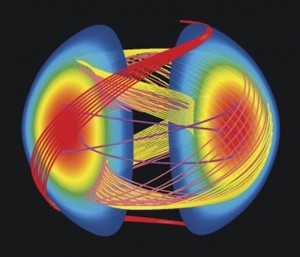
What is glass? Keck Foundation award supports University of Akron research
Three University of Akron researchers hoping to uncover the mysteries of glass formation have received a $1 million grant from the prestigious and highly selective W.M. Keck Foundation. This is the first Keck Foundation grant issued to an Ohio research team in more than five years. The Foundation, which caps its research grants at $1 million, supports projects “that are distinctive and novel in their approach, question the prevailing paradigm, or have the potential to break open new territory in their field.” The scientists are hoping to develop an algorithm that will help develop glassy materials that are both impermeable and flexible, opening pathways to electronics-embedded thin films that can be folded and unfolded without damage, coatings that prevent bridges and roads from corrosion, and vaccines that can survive absence of refrigeration.
5D optical memory in nanostructured quartz glass
Scientists at the University of Southampton (England) Optoelectronics Research Centre have experimentally demonstrated recording and retrieval processes of five-dimensional digital data by femtosecond laser writing. Said to allow “unprecedented” storage parameters, including 360 TB per disk data capacity, thermal stability up to 1000°C, and practically unlimited lifetime, the technique records data via self-assembled nanostructures created in fused quartz. Information is encoded in five dimensions: size and orientation in addition to the 3D position of these nanostructures. The scientists recorded a 300 kB digital copy of a text file using an ultrafast laser that produced extremely short and intense pulses of light. The file is written in three layers of nanostructured dots separated by 5 μm.
Nanomaterial to help reduce CO2 emissions
Researchers at the University of Adelaide (Australia) have developed a new nanomaterial that could help reduce carbon dioxide emissions from coal-fired power stations. Described in the Journal of the American Chemical Society, the material is said to efficiently separate carbon dioxide from nitrogen, the other significant component of the waste gas released by coal-fired power stations, allowing the CO2 to be stored rather than released to the atmosphere. The metal-organic framework has “remarkable selectivity” for separating CO2 from nitrogen, according to associate professor Christopher Sumby, project leader and ARC Future Fellow in the University’s School of Chemistry and Physics.
Graphene to protect silicide semiconductors?
Researchers of the Electronic Properties of Materials Group at the University of Vienna (Austria), along with coworkers at research institutes in Germany and Russia, have succeeded in fabricating a novel structure of high-quality metal silicides protected by a graphene layer. Published in the open-access journal Scientific Reports, the research is said to pave the way for integration of graphene into current silicide-based semiconductor technology. Scientists say the graphene-capped silicides under investigation are reliably protected against oxidation, cover a wide range of electronic materials and device applications, and interaction between the graphene layer and the silicide substrate is minimal.
Shape-memory alloys make jet engines quieter
(Times of India) Scientists at the Indian Institute of Science (Bangalore) and Indian Institute of Technology (Bombay) have helped aerospace engine manufacturer Rolls-Royce Ltd. develop low-noise technology for aircraft engines fitted in long-haul aircraft such as Boeing’s 747 and Dreamliner. An 11-member team of scientists began research on shape-memory alloy vanes in 2006 in collaboration with the UK company and recently delivered the technology. The vanes deploy to reduce engine noise during landing and takeoff, and are said to withstand temperatures to 200°C.

